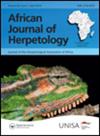两居群形态特征的两性二态性及尺度关系。产自大加那利岛的裂口虫科;鳞片虫
IF 0.9
4区 生物学
Q3 ZOOLOGY
引用次数: 6
摘要
加洛蒂亚蜥蜴属蜥蜴是加那利群岛特有的蜥蜴,其形态和颜色的变化与岛屿内地形和气候特征的变化有关。本研究探讨了来自大加那利岛西南部地区(Tasartico)和西北部地区(Gáldar)的G. sthelini种群内和种群间的两性大小二态性(SSD)、形态特征变异和尺度关系。这两个地点在气候和植被特征上存在差异,我们假设,在更开阔的栖息地,雄性个体的身体特征比雌性大,后肢长度也相对较大,这应该是SSD的表现。结果表明,两种群中三分之一的最大蜥蜴在鼻口长度(SVL)和躯干长度(TRL)上均无显著差异,但总体而言,雄性的SVL和TRL均显著大于雌性。多因素分析表明,Tasartico个体的头宽(HW)和后肢长(HLL)显著大于Gáldar个体。后肢长度是区分种群和雌雄头部参数的最重要特征。在两个种群中,头、体性状均按TRL成比例,头宽和头深呈正异速,前肢长和后肢长呈负异速。与头长(HL)相关,雌性的TRL显著大于雄性,头深显著小于雄性;Gáldar蜥蜴的躯干长度(TRL)明显大于Tasartico蜥蜴,而躯干高度(HW)和躯干高度(HLL)明显小于Tasartico蜥蜴。考虑到两个区域的生态特征,我们概述了可能影响两性形态特征进化的多种因素。本文章由计算机程序翻译,如有差异,请以英文原文为准。
Sexual dimorphism in morphological traits and scaling relationships in two populations of Gallotia stehlini (Fam. Lacertidae: Squamata) from Gran Canaria
Abstract Lizards of the genus Gallotia, endemic to the Canary Islands, show morphological and colouration varieties that are related to within island variation in orographic and climatic characteristics. This study examines sexual size dimorphism (SSD) within and between population variation in morphological traits, and scaling relationships in G. sthelini from a southwestern locality (Tasartico) and from another (Gáldar) in the northwest of Gran Canaria. Both sites differ in climate and vegetation traits, and we hypothesised that SSD should be manifested by males having relatively larger body traits than females and that hind limb lengths should be relatively larger in individuals from the more open habitat. Results showed that one-third of the largest lizards from both populations did not differ significantly either in snout-to-vent length (SVL) nor in trunk length (TRL), but overall males had significantly larger SVL and TRL than females. Multivariate analysis showed that head width (HW) and hind limb length (HLL) were significantly larger in individuals from Tasartico than in those of Gáldar. Hind limb length was the trait that contributed most to differentiate between populations and head parameters between males and females. In both populations head and body traits scaled to TRL, head width (HW) and head depth (HD) of males having a positive allometry, and fore limb length (FLL) and hind limb length (HLL) a negative one. In relation to head length (HL), females had significantly larger TRL and smaller head depths than males; lizards from Gáldar had significantly larger trunk length (TRL), but smaller HW and HLL than those of Tasartico. We outline the multiple factors that could affect the evolution of morphometric traits of each sex, taking into account the ecological features of the two zones.
求助全文
通过发布文献求助,成功后即可免费获取论文全文。
去求助
来源期刊

African Journal of Herpetology
ZOOLOGY-
CiteScore
3.00
自引率
6.70%
发文量
15
审稿时长
>12 weeks
期刊介绍:
African Journal of Herpetology (AJH) serves as an outlet for original research on the biology of African amphibians and reptiles. AJH is an interdisciplinary journal that publishes original articles and reviews from diverse fields and disciplines, such as conservation, phylogenetics, evolution, systematics, performance, physiology, ecology, behavioural ecology, ethology, and morphology.
The Journal publishes two issues a year. There are no page charges .
 求助内容:
求助内容: 应助结果提醒方式:
应助结果提醒方式:


